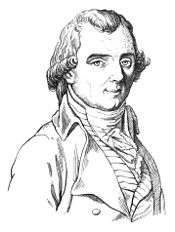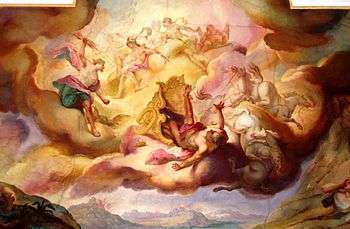Phaeton (hypothetical planet)
Phaeton (or Phaëton), was the hypothetical planet theorized by Titius–Bode law to have existed between the orbits of Mars and Jupiter whose destruction supposedly led to the formation of the asteroid belt (including Ceres). The hypothetical planet was named for Phaethon, the son of the sun god Helios in Greek mythology, who attempted to drive his father's solar chariot for a day with disastrous results and was ultimately destroyed by Zeus.[1]
Phaeton hypothesis


According to the discredited Titius–Bode law, a planet was believed to exist between Mars and Jupiter. After observing the discoveries made by the German astronomer and professor Johann Daniel Titius (1729–1796), Johann Elert Bode himself urged a search for the fifth planet. When Ceres, the largest of the asteroids in the asteroid belt (now considered a dwarf planet), was serendipitously discovered in 1801 by the Italian Giuseppe Piazzi and found to match the predicted position of the fifth planet, many believed it was the missing planet. However, in 1802 astronomer Heinrich Wilhelm Matthäus Olbers discovered and named another object in the same general orbit as Ceres, the asteroid Pallas.
Olbers proposed that these new discoveries were the fragments of a disrupted planet that had formerly orbited the Sun. He also predicted that more of these pieces would be found. The discovery of the asteroid Juno by Karl Ludwig Harding and Vesta, by Olbers, buttressed the Olbers hypothesis.
In 1823, German linguist and retired teacher Johann Gottlieb Radlof called Olbers' destroyed planet "Phaëthon," linking it to the Greek myths and legends about Phaethon and others.[2][3] His ideas were similar to those later advocated by Immanuel Velikovsky.[3] Despite Radlof's precedence, Russian authors of the 20th century claimed that, "The hypothetical planet of Olbers' was left nameless for a century and a half. Only in 1949 did the well-known Soviet astronomer S[ergej] V[ladirimovich] Orlov give it the name Phaeton... This name has become established."[4]
Theories regarding the formation of the asteroid belt from the destruction of a hypothetical fifth planet are today collectively referred to as the "disruption theory". This theory states that there was once a major planetary member of our solar system circulating in the present gap between Mars and Jupiter, which was variously destroyed when:
- it veered too close to Jupiter and was torn apart by its powerful gravity
- it was struck by another large celestial body
- it was destroyed by a hypothetical brown dwarf, the companion star to the Sun, known as Nemesis
- it was shattered by some internal catastrophe
Today, the Phaeton hypothesis has been superseded by the accretion model.[5] Most astronomers today believe that the asteroids in the main belt are remnants of the protoplanetary disk, and in this region the incorporation of protoplanetary remnants into the planets was prevented by large gravitational perturbations induced by Jupiter during the formative period of the solar system.
Other hypotheses
Some scientists and non-scientists continue to advocate for the existence and destruction of a Phaeton-like planet.
Zecharia Sitchin suggested that the goddess known to the Sumerians as Tiamat in fact relates to a planet that was destroyed by a rogue planet known as Nibiru, creating both Earth and the asteroid belt.[6] His work is widely regarded as pseudoscience.[7]
The astronomer and author Tom Van Flandern held that Phaeton exploded through some internal mechanism. In his "Exploded Planet Hypothesis 2000", he lists possible reasons for its explosion: a runaway nuclear reaction of uranium in its core, a change of state as the planet cooled down creating a density phase change, or through continual absorption of heat in the core from gravitons.[8][9][10]
In 1972, Soyuzmultfilm studies produced an animated short film titled Фаэтон - Сын Солнца (Phaeton: The Son of Sun), directed by Vasiliy Livanov (Василий Ливанов), in which the subject of the asteroid belt is treated as the remains of a planet.
Phaeton in literature
Several works of fiction feature a supposed planet (sometimes named Phaeton) existing in the past between the orbits of Mars and Jupiter, which somehow became the Solar System's asteroid belt.
See also
Sources
Books

- Christy-Vitale, Joseph (2004). Watermark: The Disaster That Changed the World and Humanity 12,000 Years Ago. New York: Simon and Schuster.
- Cole, Dandridge M.; Cox, Donald William (1964). Islands in Space: The Challenge of the Planetoids. Philadelphia: Chilton Books.
- McSween, Harry Y. (2004). Meteorites and Their Parent Planets. Cambridge: Cambridge University Press.
- Annals of the New York Academy of Sciences. New York Academy of Sciences. , Records of meetings 1808–1916 in v. 11–27, p. 872.
References
- ↑

- ↑ Radlof, Johann Gottlieb (1823). Zertrümmerung der großen Planeten Hesperus und Phaeton, und darauf folgenden Zerstörungen und Ueberflutung auf der Erde. Berlin: G. Reimer. p. 59.
- 1 2 van der Sluijs, Marinus Anthony. "Johan Radlof: The Father of Planetary Catastrophism". Mythopedia.info. Retrieved 2017-03-21.
- ↑ Bronshten, V.A. "Origin of the Asteroids". Zemlya i Vselennaya. Retrieved 2017-03-22.
- ↑ "Ask an Astrophysicist". imagine.gsfc.nasa.gov.
- ↑ Sitchin, Zecharia (1990). "Chapter 2: It Came From Outer Space". Genesis Revisited. New York: Avon Books. ISBN 0380761599.
- ↑ Carroll, Robert T (1994–2009). "Zecharia Sitchin and The Earth Chronicles". The Skeptic's Dictionary. John Wiley & Sons. Retrieved 2016-02-05.
- ↑ Van Flandern, Tom. org/solar% 20system/eph/eph2000. asp "The Exploded Planet Hypothesis 2000". Meta Research, (2000).
- ↑ Flandern, Tom Van (2007). "The challenge of the exploded planet hypothesis". International Journal of Astrobiology. 6 (03): 185. Bibcode:2007IJAsB...6..185V. doi:10.1017/S1473550407003758. ISSN 1473-5504.
- ↑ Van Flandern, Tom. Dark Matter, Missing Planets and New Comets: Paradoxes Resolved, Origins Illuminated. North Atlantic Books, 1999.
External links
- J. Timothy Unruh, Phaeton, The Lost Planet: An Ancient World that Perished, An Astronomer's Account of the Missing Planet Between Mars and Jupiter as Interpreted from Observations Made Within a Biblical Context – an online book that posits that the planet Phaeton played a role in Noah's Flood
- J. Timothy Unruh, "Phaeton, The Lost Planet: An Ancient World that Perished," Planetary Papers, No. 6 – a condensed version of Unruh's book
- Kevin O'Flynn, " Asteroid Could End World Monday," Asteroid News, December 16, 2000